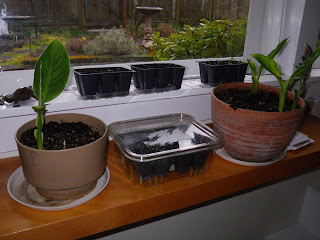Flowers always make people better, happier, and more helpful; they are sunshine, food, and medicine to the soul.
~Luther Burbank, 1849-1926
Did you ever wonder how many plants it takes to create those full, overflowing, lush flowering baskets of annuals that you see hanging from the lamp posts on your local Main street?
This is basket week at the municipal greenhouse where I volunteer. We are planting thousands of plants in large wire and moss baskets that will eventually beautify lamp posts near and far on city streets. Just look at them…rows and rows of moss baskets. The baskets I planted today are destined to beautify Safeco Field in Seattle…home of our Mariners baseball team.
The pot pictured below is 20 inches (51 cm) in diameter. In it I have placed 20 plugs of differing but all cascading varieties of annuals. I have planted them in two offset circles, so as the plants closer to the center cascade they won’t completely cover the plant at the edge. In the center is a Begonia ‘bonfire’ which is upright but will also hang over as the stems lengthen.
At the greenhouse we plant ‘plugs’. As you can see below they are quite small but well rooted and used more in commercial applications because of volume and cost. At your local nursery you’ll find annuals often in ‘basket stuffer’ sizes, usually 2 inch (5 cm) pots. Even at that size you can still get 20 in this pot. Make sure to read the label and get everything in trailing or cascading varieties. Trailing lobelia, verbena, lotus vine, trailing begonia, calibrachoa, petunia, diascia, ivy geranium are all great for hanging pots. Something upright in the center will add height. Make sure all the plants you choose have the same light needs and are specified on the plant’s tags. If your basket is going to be in full sun be sure all the plants are labeled for full sun.
The brown plastic tubing lying in the pot is a part of the watering system Safeco Field uses. You definitely want to get that in place from the very beginning before the plants start to fill out if you are going to use a watering system like that.
Baskets need more attention to watering. Since they are made of wire and a mossy liner which allows more air flow and being suspended in the air and wind, they will dry out faster than terracotta or plastic pots. In mid summer, on a sunny, hot day you may need to water them two times a day.
Organic fertilizers are slow release naturally, so mixing in a handful of granular organic fertilizer before you put in your plants should feed your basket for 3-4 months. If you feel it needs a boost after 3 months or so you’ll want to switch to a liquid organic fertilizer, using every few weeks. Organic dry fertilizers need to be mixed into the soil, not just sprinkled on top. It will be too hard to mix in a dry type with all the plants and you don’t want to damage the lovely jumble of vines.
So now that your plants are in, all you need is sun, warmth, water and fertilizer and you too can have a beautiful, full hanging basket of colorful annuals this summer.
In Bloom In My Garden Today: Muscari (Grape Hyacinths), Hyacinths, Tulipa turkistanica, Corylopsis veitch (Winter Hazel), Hepatica, Daffodil, primrose (double English), Heleborus, Bellis perennis (English daisy), violet primrose
Author’s photos







